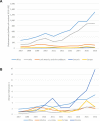Accountability for funds for Nurturing Care: what can we measure?
- PMID: 30885964
- PMCID: PMC6557225
- DOI: 10.1136/archdischild-2018-315429
Accountability for funds for Nurturing Care: what can we measure?
Abstract
Background: Understanding donor, government and out-of-pocket funding for early child development (ECD) is important for tracking progress. We aimed to estimate a baseline for the WHO, UNICEF and World Bank Nurturing Care Framework (NCF) with a special focus on childhood disability.
Methods: To estimate development assistance spending, the Organisation for Economic Cooperation and Development's Creditor Reporting System (OECD-CRS) database was searched for 2007-2016, using key words derived from domains of the NCF (good health, nutrition and growth, responsive caregiving, security and safety, and early learning), plus disability. Associated funds were analysed by domain, donor, recipient and region. Trends of ECD/NCF were compared with reproductive, maternal, newborn and child health (RMNCH) disbursements. To assess domestic or out-of-pocket expenditure for ECD, we searched electronic databases of indexed and grey literature.
Results: US$79.1 billion of development assistance were disbursed, mostly for health and nutrition (US$61.9 billion, 78% of total) and least for disability (US$0.7 billion, 2% of total). US$2.3 per child per year were disbursed for non-health ECD activities. Total development assistance for ECD increased by 121% between 2007 and 2016, an average increase of 8.3% annually. Per child disbursements increased more in Africa and Asia, while minimally in Latin America and the Caribbean and Oceania. We could not find comparable sources for domestic funding and out-of-pocket expenditure.
Conclusions: Estimated international donor disbursements for ECD remain small compared with RMNCH. Limitations include inconsistent donor terminology in OECD data. Increased investment will be required in the poorest countries and for childhood disability to ensure that progress is equitable.
Keywords: early child development; nurturing care framework; official donor assistance; responsive care; tracking.
© Author(s) (or their employer(s)) 2019. Re-use permitted under CC BY-NC. No commercial re-use. See rights and permissions. Published by BMJ.
Conflict of interest statement
Competing interests: None declared.
Figures






Similar articles
-
11 years of tracking aid to reproductive, maternal, newborn, and child health: estimates and analysis for 2003-13 from the Countdown to 2015.Lancet Glob Health. 2017 Jan;5(1):e104-e114. doi: 10.1016/S2214-109X(16)30304-7. Lancet Glob Health. 2017. PMID: 27955769 Free PMC article.
-
Estimates of aid for reproductive, maternal, newborn, and child health: findings from application of the Muskoka2 method, 2002-17.Lancet Glob Health. 2020 Mar;8(3):e374-e386. doi: 10.1016/S2214-109X(20)30005-X. Epub 2020 Feb 5. Lancet Glob Health. 2020. PMID: 32035034 Free PMC article.
-
Tracking development assistance for health and for COVID-19: a review of development assistance, government, out-of-pocket, and other private spending on health for 204 countries and territories, 1990-2050.Lancet. 2021 Oct 9;398(10308):1317-1343. doi: 10.1016/S0140-6736(21)01258-7. Epub 2021 Sep 22. Lancet. 2021. PMID: 34562388 Free PMC article. Review.
-
Assessing development assistance for child survival between 2000 and 2014: A multi-sectoral perspective.PLoS One. 2017 Jul 11;12(7):e0178887. doi: 10.1371/journal.pone.0178887. eCollection 2017. PLoS One. 2017. PMID: 28700612 Free PMC article.
-
Public and private donor financing for health in developing countries.Infect Dis Clin North Am. 1991 Jun;5(2):221-34. Infect Dis Clin North Am. 1991. PMID: 1869807 Review.
Cited by
-
Who actually cares for children in slums? Why we need to think, and do, more about paid childcare in urbanizing sub-Saharan Africa.Philos Trans R Soc Lond B Biol Sci. 2021 Jun 21;376(1827):20200430. doi: 10.1098/rstb.2020.0430. Epub 2021 May 3. Philos Trans R Soc Lond B Biol Sci. 2021. PMID: 33938281 Free PMC article.
-
Rating early child development outcome measurement tools for routine health programme use.Arch Dis Child. 2019 Apr;104(Suppl 1):S22-S33. doi: 10.1136/archdischild-2018-315431. Arch Dis Child. 2019. PMID: 30885963 Free PMC article.
-
Early Intervention for Children at High Risk of Developmental Disability in Low- and Middle-Income Countries: A Narrative Review.Int J Environ Res Public Health. 2019 Nov 13;16(22):4449. doi: 10.3390/ijerph16224449. Int J Environ Res Public Health. 2019. PMID: 31766126 Free PMC article. Review.
-
The Impact of Global Collaboration on the Academic Focus of the West African College of Surgeons: Are Worldwide Efforts Aligning with Local Priorities?World J Surg. 2023 Oct;47(10):2319-2327. doi: 10.1007/s00268-023-07075-5. Epub 2023 Jun 7. World J Surg. 2023. PMID: 37284848
-
Reaching the dream of optimal development for every child, everywhere: what do we know about 'how to'?Arch Dis Child. 2019 Apr;104(Suppl 1):S1-S2. doi: 10.1136/archdischild-2019-317087. Arch Dis Child. 2019. PMID: 30885960 Free PMC article. No abstract available.
References
-
- World Health Organisation. Nurturing care framework, 2018. https://www.who.int/maternal_child_adolescent/child/nurturing-care-frame...
-
- UNICEF. Early Moments Matter for Every Child, 2017.
